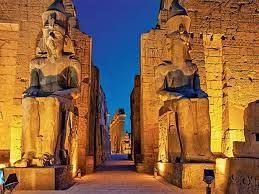A trip to a valley of the kings is a dream for many travelers fascinated by ancient Egypt and its mysteries.
This famous burial site lies on the west bank of the Nile in Luxor, near the ruins of ancient Thebes.
It served as the royal necropolis for pharaohs and nobles during Egypt’s Eighteenth to Twentieth Dynasties.
Over 60 tombs carved into cliffs contain rich artwork and hidden chambers filled with funerary treasures and ancient secrets.
Tombs here belong to legendary figures like Tutankhamun, Seti I, and Ramses II.
If you love history or plan Valley of the Kings tours, this guide covers what you need to know.
You’ll learn when it was built, who’s buried there, and explore Valley of the Kings facts you won’t find elsewhere.
We’ll cover opening hours, ticket prices in dollars, travel tips, and how to explore the tombs.
Walk inside the decorated corridors and discover the stories behind the Eighteenth Dynasty of Egypt family tree.
Get ready to step into one of the world’s most extraordinary archaeological wonders—let’s begin your journey.
1. What Is the Valley of the Kings and Why Is It Famous?
The Valley of the Kings is a rocky desert canyon west of Luxor, known for royal tombs hidden in limestone hills.
It replaced the pyramids of earlier dynasties because it offered better protection from grave robbers.
Pharaohs of the New Kingdom were buried here from about 1550 BCE to 1070 BCE.
The tombs feature hieroglyphic inscriptions, sacred art, and long corridors leading to burial chambers.
Many of them reflect beliefs about the afterlife and the sun god Ra.
Today, visitors walk the paths of ancient priests, nobles, and tomb builders who shaped Egyptian funerary culture.
2. When Was the Valley of the Kings Built?
Tomb building began during the reign of Thutmose I in the early Eighteenth Dynasty of Egypt around 1500 BCE.
The area was active for almost 500 years, through the Nineteenth and Twentieth Dynasties.
Builders carved tombs deep into the cliffs, hoping to keep them hidden from looters.
Despite these efforts, most tombs were robbed long ago, except for a few like Tutankhamun’s.
The valley’s design, secrecy, and religious meaning make it a unique burial ground in world history.
3. A Legacy of the Eighteenth Dynasty of Egypt
The Eighteenth Dynasty of Egypt family tree includes rulers like Hatshepsut, Amenhotep III, Akhenaten, and Tutankhamun.
These rulers chose the Valley of the Kings for burial instead of pyramids or temples.
Each tomb reflects their power, style, and religious devotion to Amun and the sun god Ra.
Tombs from this period are richly decorated with spiritual texts like the Book of the Dead.
Their choices shaped burial practices for later generations of kings and nobles.
4. The Most Important People Buried in the Valley
Many important people in ancient Egypt were laid to rest here. Let’s highlight the most famous names:
-
Tutankhamun: His nearly untouched tomb was discovered in 1922, filled with gold and sacred objects.
-
Seti I: Known for having one of the longest, most beautiful tombs in the valley.
-
Ramses II: The powerful builder king, also called Ramses the Great, buried in tomb KV7.
-
Hatshepsut: Egypt’s most famous female pharaoh, originally buried in tomb KV20.
-
Thutmose III: His tomb is hidden high in the cliffs, requiring a steep climb.
These ancient kings were considered divine and took great care in preparing for eternal life.

egypt cairo to luxor best ways to get there nile cruise
5. The Architecture Inside the Valley of the Kings
Each tomb is different but shares common features like sloping corridors, deep shafts, and hidden rooms.
Walls are covered with colorful hieroglyphs and illustrations showing gods, rituals, and afterlife journeys.
Some tombs include astronomical ceilings, false doors, and sacred offerings carved in stone.
The tomb of Seti I (KV17) is among the most artistically detailed in the entire valley.
Tomb KV5, built for Ramses II’s sons, contains more than 120 chambers—one of the largest found.
Going inside the Valley of the Kings is like walking through a sacred underground temple.
6. Amazing Valley of the Kings Facts Tourists Don’t Know
-
The valley includes over 63 known tombs, with more possibly still undiscovered.
-
Tombs are numbered KV1 to KV64, in the order they were found, not by dynasty or age.
-
Greek and Roman tourists left graffiti on tomb walls over 2,000 years ago.
-
Most tombs were looted in antiquity, yet many still hold valuable clues for researchers.
-
KV64 was discovered as recently as 2011 and belonged to a priestess named Nehmes Bastet.
These Valley of the Kings facts show how history is still being uncovered in modern times.
7. How to Plan Your Trip to the Valley of the Kings
A trip to a valley of the kings requires planning to make the most of your visit.
The site is open daily, usually from 6:00 AM to 4:00 PM, depending on the season.
Arrive early to beat the heat and avoid long lines at the tombs.
Dress in light clothing, wear a hat, and bring water for hydration in the desert environment.
Photography is allowed with a separate ticket; flash is not permitted inside the tombs.
Buy your tickets at the main entrance or in advance through a licensed travel provider.
8. Ticket Prices and What They Include
Tickets are priced in Egyptian pounds but can be easily converted to US dollars. Here’s an average:
-
General Entry: 750 EGP (~$40) — includes three tombs of your choice.
-
Tutankhamun Tomb: 700 EGP (~$37) — a separate ticket is required.
-
Seti I Tomb: 2,000 EGP (~$105) — highly recommended but limited in access.
-
Ay Tomb: 200 EGP (~$11) — worth a quick visit.
-
Tram Ticket: 5 EGP (~$0.25) — brings you from the entrance to the tomb area.
Prices may change, so check with local tour guides before your visit.
9. Recommended Valley of the Kings Tours
Many companies offer Valley of the Kings tours departing from Luxor, Hurghada, or Cairo.
Choose from group tours, private guides, or full-day packages with hotel pickup and lunch.
Private tours cost more but allow flexible schedules and deeper exploration of specific tombs.
Some packages include Karnak Temple, Hatshepsut Temple, and the Colossi of Memnon.
If you’re short on time, focus on visiting three tombs plus Tutankhamun’s.
Booking in advance ensures access to limited tombs like Seti I or Ramses V.
10. Safety Tips and Entry Requirements
Safety at the site is excellent, but basic precautions help make your trip to a valley of the kings smooth.
Always carry sunscreen, water, and your ticket. Replacements may cost more or be unavailable.
Children under six usually enter free, while ages six to twelve receive discounts.
Student IDs from international schools or universities can earn you up to 50% off.
Avoid touching walls or artifacts—doing so damages the artwork and may result in fines.
Respect posted signs and follow the guide’s instructions when entering and exiting the tombs.
Conclusion
The Valley of the Kings is more than a burial site—it’s a journey into Egypt’s golden age of rulers and belief.
Every corridor and carving tells a story from the time of the ancient kings and the gods they worshipped.
If you’re ready for a trip to a valley of the kings, prepare to witness history carved in stone and legend.
With this guide, you now understand the tombs, timelines, ticket options, and travel tips to enrich your adventure.
So pack your curiosity, and get ready to step into one of the world’s most sacred landscapes of power and legacy.






